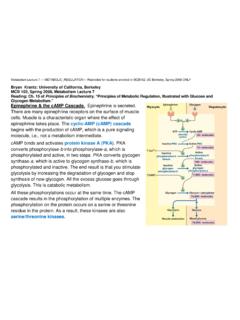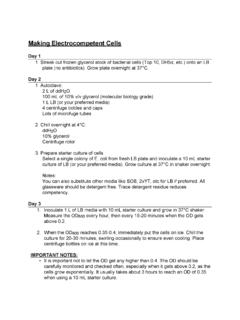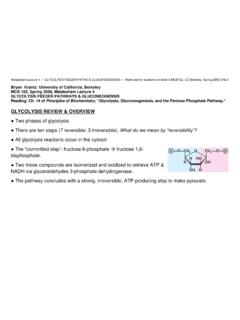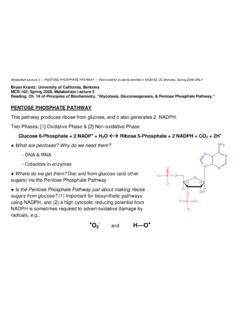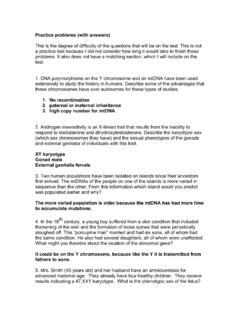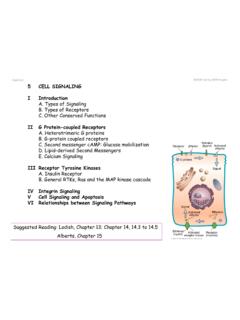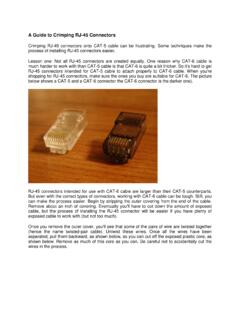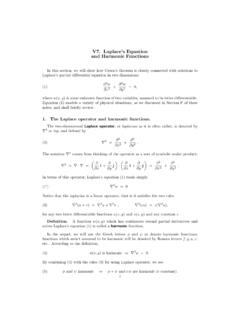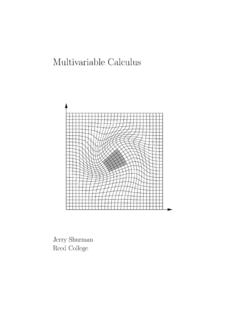Transcription of A quick guide to sketching phase planes
1 A quick guide to sketching phase planesSection of the text discusses equilibrium points and analysis of the phase plane. However,there is one idea, not mentioned in the book, that is very useful to sketching and analyzing phaseplanes, namelynullclines. Recall the basic setup for an autonomous system of two DEs:dxdt=f(x, y)dydt=g(x, y)To sketch the phase plane of such a system, at each point(x0, y0)in thexy-plane, we draw a vectorstarting at(x0, y0)in the directionf(x0, y0)i+g(x0, y0) of a set of points in the phase plane so thatdxdt= , these are the points where the vectors are either straight up or straight down. Alge-braically, we find thex-nullcline by solvingf(x, y) = a set of points in the phase plane so thatdydt= 0. Geometrically, these are thepoints where the vectors are horizontal, going either to theleft or to the right. Algebraically, wefind they-nullcline by solvingg(x, y) = to use the systemdxdt= 2x(1 x2) xy,dydt= 3y(1 y3) find thex-nullcline, we solve2x(1 x2) xy= 0, where multiplying out and collecting thecommon factor ofxgivesx(2 x y) = 0.
2 This gives twox-nullclines, the linex+y= 2andthey-axis. By plugging in the points (1,0) and (2,2) into2x(1 x2) xy, we see that solutions(to the left of they-axis) move to the right if below the linex+y= 2and to the left if above find they-nullcline, we solve3y(1 y3) 2xy= 0, where multiplying out and collecting thecommon factor ofygivesy(3 y 2x) = 0. This gives twoy-nullclines, the line2x+y= 3andthex-axis. By plugging in the points (0,1) and (2,2) into3y(1 y2) 2xy, we see that solutions(above thex-axis) move up if below the line2x+y= 3and down if above this information gives us the following picture. Notice that we can draw directionson each nullcline by using the direction information from the other graph. For example, the linesegment from(1,1)to(0,3), since it is above the linex+y= 2, has solutions moving to the , where thex-nullcline andy-nullcline cross, bothdxdtanddydtare zero.
3 So these points(marked by dots in the above graph) are equilibrium a solution enters the triangle with vertices(1,1),(0,2)and(0,3), it can never , solutions in the triangle with vertices(1,1),(3/2,0)and(2,0)can never the nullclines and discuss the possible fates of solutions for the following sys-tems. The nullclines may not be straight lines.(1)dxdt=x( x 3y+ 150),dydt=y( 2x y+ 100).(2)dxdt=x(10 x y),dydt=y(30 2x y).(3)dxdt= 2x(1 x2) xy,dydt=y(94 y2) x2y.(4)dxdt=x( 4x y+ 160),dydt=y( x2 y2+ 2500).2 Qualitative AnalysisThu Dec 30 2004 11:43:20 US/ 1 Differential EquationsGet C. Henry Edwards book w/ free shipping. Sign up EquationsSolve systems quickly and efficientlywith equations?Algebrator shows, explains steps toany linear equations problem!Calculus Solver 24/7differentiate, integrate, graph seesteps automatically on the webAds by Goooooogle Qualitative AnalysisVery often it is almost impossible to find explicitly of implicitly the solutions of a system (specially nonlinear ones).
4 The qualitative approach aswell as numerical one are important since they allow us to make conclusions regardless whether we know or not the solutions. Recall what we did for autonomous equations. First we looked for the equilibrium points and then, in conjunction with the existence anduniqueness theorem, we concluded that non-equilibrium solutions are either increasing or decreasing. This is the result of looking at the signof the derivative. So what happened for autonomous systems? First recall that the components of the velocity vectors are and . Thesevectors give the direction of the motion along the trajectories. We have the four natural directions (left-down, left-up, right-down, and right-up) and the other four directions (left, right, up, and down). These directions are obtained by looking at the signs of and and whetherthey are equal to 0. If both are zero, then we have an equilibrium Consider the model describing two species competing for the same preyLet us only focus on the first quadrant and.
5 First, we look for the equilibrium points. We must haveAlgebraic manipulations implyandThe equilibrium points are (0,0), (0,2), (1,0), and .Consider the region R delimited by the x-axis, the y-axis, the line 1-x-y=0, and the line 2-3x-y=0. Differential EquationsGet C. Henry Edwards book w/ free shipping. Sign up EquationsSolve systems quickly and efficientlywith equations?Algebrator shows, explains steps toany linear equations problem!Calculus Solver 24/7differentiate, integrate, graph seesteps automatically on the webAds by GoooooogleQualitative AnalysisThu Dec 30 2004 11:43:21 US/ 2 Clearly inside this region neither or are equal to 0. Therefore, they must have constant sign (they are both negative). Hence thedirection of the motion is the same (that is left-down) as long as the trajectory lives inside this region. In fact, looking at the first-quadrant, we have three more regions to add to the above one.
6 The direction of the motion depends on whatregion we are in (see the picture below)The boundaries of these regions are very important in determining the direction of the motion along the trajectories. In fact, it helps tovisualize the trajectories as slope-field did for autonomous equations. These boundaries are called the autonomous systemThe x-nullcline is the set of points where and y-nullcline is the set of points where . Clearly the points of intersectionbetween x-nullcline and y-nullcline are exactly the equilibrium points. Note that along the x-nullcline the velocity vectors are vertical whilealong the y-nullcline the velocity vectors are horizontal. Note that as long as we are traveling along a nullcline without crossing an equilibriumpoint, then the direction of the velocity vector must be the same. Once we cross an equilibrium point, then we may have a change in thedirection (from up to down, or right to left, and vice-versa).
7 Example. Draw the nullclines for the autonomous system and the velocity vectors along AnalysisThu Dec 30 2004 11:43:22 US/ 3 The x-nullcline are given bywhich is equivalent towhile the y-nullcline are given bywhich is equivalent toIn order to find the direction of the velocity vectors along the nullclines, we pick a point on the nullcline and find the direction of the velocityvector at that point. The velocity vector along the segment of the nullcline delimited by equilibrium points which contains the given point willhave the same direction. For example, consider the point (2,0). The velocity vector at this point is (-1,0). Therefore the velocity vector at anypoint (x,0), with x > 1, is horizontal (we are on the y-nullcline) and points to the left. The picture below gives the nullclines and the velocityvectors along this example, the nullclines are lines. In general we may have any kind of curves.
8 Example. Draw the nullclines for the autonomous systemThe x-nullcline are given bywhich is equivalent towhile the y-nullcline are given byQualitative AnalysisThu Dec 30 2004 11:43:22 US/ 4which is equivalent toHence the y-nullcline is the union of a line with the ellipseInformation from the nullclinesFor most of the nonlinear autonomous systems, it is impossible to find explicitly the solutions. We may use numerical techniques to have anidea about the solutions, but qualitative analysis may be able to answer some questions with a low cost and faster than the numericaltechnique will do. For example, questions related to the long term behavior of solutions. The nullclines plays a central role in the qualitativeapproach. Let us illustrate this on the following Discuss the behavior of the solutions of the autonomous systemWe have already found the nullclines and the direction of the velocity vectors along these nullclines.
9 These nullclines give the birth to four regions in which the direction of the motion is constant. Let us discuss the region bordered by the x-axis, the y-axis, the line 1-x-y=0, and the line 2-3x-y=0. Then the direction of the motion is left-down. So a moving object starting at aposition in this region, will follow a path going left-down. We have three choicesFirst choice: the trajectory dies at the equilibrium point .Qualitative AnalysisThu Dec 30 2004 11:43:22 US/ 5 Second choice: the starting point is above the trajectory which dies at the equilibrium point . Then the trajectory will hit thetriangle defined by the points , (0,1), and (0,2). Then it will go up-left and dies at the equilibrium point (0,2).Third choice: the starting point is below the trajectory which dies at the equilibrium point . Then the trajectory will hit thetriangle defined by the points , (1,0), and . Then it will go down-right and dies at the equilibrium point (1,0).
10 For the other regions, look at the picture below. We included some solutions for every We see from this example that the trajectories which dye at the equilibrium point are crucial to predicting the behavior ofthe solutions. These two trajectories are called separatrix because they separate the regions into different subregions with a specific find them is a very difficult problem. Notice also that the equilibrium points (0,2) and (1,0) behave like sinks. The classification ofequilibrium points will be discussed using the approximation by linear you would like more practice, click on Example.[Differential Equations] [First Order ][Geometry] [Algebra] [Trigonometry ][Calculus] [Complex Variables] [Matrix Algebra] MATH ematics home pagePlanetMath: some qualitative analysis of FitzHugh-Nagumo equation using nullclinesThu Dec 30 2004 11:49:12 US/ 1(more info)World Encyclopedia BookDiscount World Encyclopedia Book Check outthe deals now!
